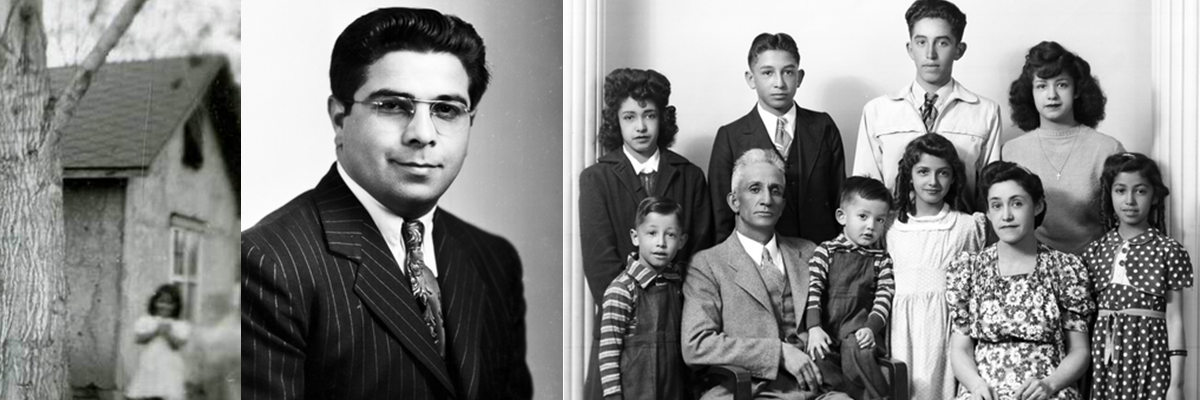
Pictured above, from left to right, are 724 Martinez Street in Alta Vista in 1949, Dr. William Lopez, and the Lee Martinez family.
The following text is excerpted from Hang your Wagon to a Star: Hispanics in Fort Collins, 1900-2000, a Historical Context by Adam Thomas, 2003.
The first substantiated Hispanic settler in Larimer County was also the first European in the Big Thompson River Valley. Mariana Modena came here in 1858 with his Native American wife and five children. He had previously discovered the location while on one of his many trips trapping and hunting with Kit Carson and Jim Baker.
Many Hispanic families followed Modena to what is now Larimer County and, like their Anglo neighbors, took advantage of liberal homesteading policies such as the Homestead Act. The José de Jesús Aragón family, ancestors of some of the area's most prominent Hispanic families, came to Fort Collins in a caravan from New Mexico. Familiar with livestock feeding and irrigated farming, the individual families scattered onto farms and ranches across northern Colorado. Many Hispanic men worked in limestone quarries north of Fort Collins or on railroad section gangs. Later they toiled in sugar beet fields and at the refinery.
Pulling Hispanics to northern Colorado was the Great Western Sugar Company (Great Western), which found its traditional sources of labor quickly vanishing. Beet sugar had become the "white gold" of Colorado. In 1904, Fort Collins completed its own sugar factory, processing sugar beets into granulated sugar. In time, the factory became part of Great Western, the largest beet sugar corporation in the United States. But even before Fort Collins opened its sugar factory, families of Germans from Russia were at work in Larimer County's beet fields... Many [of these] families rose quickly from contract laborers, to tenant farmers, to farm owners. At the same time, immigration policies tightened and, in the wake of World War I, European immigration all but ceased. Consequently, as Germans from Russia left contract labor positions, Great Western struggled to find replacements... "push" factors in Mexico and the southwest made the overtures of labor recruiters all the more appealing to Hispanics. Rumors spread of quick prosperity to be found in the beet fields of Colorado. Moreover, government policies limiting European immigration actually made crossing the Mexican-U.S. border easier.
Western farm lobbyists convinced Congress to exempt Mexicans from its immigration policies for two reasons. First, without European immigration, growers needed a dependable source of cheap labor. Second, they argued that Mexicans had no desire to reside in the United States and would, at the end of the season, return to south of the border. Soon, thousands of Hispanic families migrated to and settled in northern Colorado.
In isolated neighborhoods north of downtown [Fort Collins], Hispanic families forged a strong and vibrant community, steeped in traditions spanning centuries. But venturing from these neighborhoods... was to enter a culture of discrimination. Store windows displayed signs reading "No Dogs or Mexicans Allowed." Teachers often sat Hispanic students in the back of the classroom, figuring that they were unwilling or unable to learn. Despite these obstacles, Hispanics in Fort Collins managed to create and retain a lively, expressive culture. Holy Family Catholic Church hosted an array of Latino spiritual and social gatherings, and the church, like the Hispanic neighborhoods, served as a sanctuary from Anglo criticism.
The Great Depression and World War II produced a new generation of Hispanic leaders who sought to combat poverty, end discrimination, secure basic social services, and guarantee quality education. From their small homes in Andersonville, Buckingham, AltaVista, or the Holy Family Neighborhood, shanties beside beet fields, and cramped hotel rooms in Fort Collins, the Hispanic community has displayed a remarkable ability to overcome adversity and create new opportunities for future generations.


Preserving the history of Fort Collins, Colorado & the Cache la Poudre region